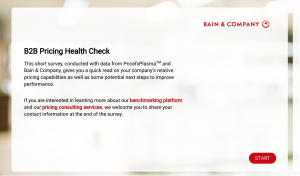Essential Industry-relevant Benchmarks and Standardized KPIs for Pricing Success
May 26th, 2021 (Updated 05/28/2021) | 7 min. read
Essential Industry-relevant Benchmarks and Standardized KPIs for Pricing Success
While theories about how price affects the market, response go back to John Maynard Keynes in the 1930s, Pricing as a professional discipline has only really been a topic of conversation since the early 1990s. Since then, pricing professionals have been playing catch up to mature procurement processes and capabilities. The challenges have been both internal and external – few companies have had the data to measure their own performance, and there has been no objective source of truth to help executives really know what good pricing looks like.
Even 30 years later, Pricing is often considered a company’s “secret sauce,” even though many executives do not know or understand how pricing is managed in their organizations. It is often treated like a dark art that requires a special relationship and proprietary knowledge of the customer to know a specific customer’s willingness to pay. The reality is that in the last few decades, much progress has been made in professionalizing pricing. Unfortunately, much of the knowledge has been stored in the heads of individuals, meaning that it was not broadly known or well codified. Also, it was hard to separate the measurement of good practices and capabilities from the measurement of outcomes that is important for protecting competitive advantage and legality. Therefore, if and when a company got it right, it was hard for other executives to learn from their experience. Pricing capability building has often seemed a bespoke effort.
This lack of community learning has led to a continuation of the capability and information asymmetry that has made it difficult for companies to sustain pricing gains. Additionally, senior executives have found it difficult to prioritize Pricing projects. Though there is broad evidence that Pricing is a powerful lever, it is also a complex lever to pull. Pricing has often not had a single executive owner. Responsibilities might be distributed across sales, marketing, product, and/or finance. Without any point of agreed authority or accountability in pricing, there is often disagreement about pricing performance, even which data to use for measurement. Without such agreement, a business case for change is very difficult to build. The unfortunate result is that executives often ignore this most powerful of profit levers because other levers are easier to pull.
The brainchild of Pricefx and Bain & Company, PricefxPlasma is the first (and only) pricing analytics and intelligence platform that gives companies access to reliable quantitative benchmarks to objectively measure and compare their pricing capabilities and performance against peers in comparable companies. This is not about comparing price points. It provides a much deeper, much more sustainable level of insight to help companies understand how they measure up against industry trends, peers, and competitors and be able to dynamically track relative improvement over time.
With PricefxPlasma came transparent industry insights – a way of sharing what “good” looks like.
The Importance of Industry-relevant Benchmarking and Standardized KPIs
The importance of KPIs cannot be overstated. Simply put, it’s how we understand performance against our business objectives. PricefxPlasma was designed to provide a broad set of standard KPIs that can serve a company at any level of maturity. Like any comprehensive scorecard of KPIs, it captures and provides metrics in two broad categories, process, and outcomes. Outcome-based metrics help companies measure progress against stated business objectives. Process metrics provide insight into the “why” of the outcomes. They answer questions like the following:
- Where do our controls break down?
- What is driving our increased cycle time?
- How did our new policy affect decision flow?
KPIs from deep inside the operations of a Pricing organization have never before been available in a codified form. Historically, Pricing executives had to depend on only discrete studies and anecdotal information. This depth of insight is truly unique.
However, when looking broadly across multiple industries, pricing benchmarks often lose relevance. Ways of working, expected cycle times, the complexity of deals, and customer and competitive dynamics all can significantly affect metrics. The pricing profiles, dynamics, statistics, velocities, etc., of a software company (for example), look very different than the distributor that sells that software to the end customer. And if a greater separation is factored in – perhaps a software company and a chemicals company – that difference only gets larger. The marginal cost to produce an additional version of the software is going to be minimal. Whereas a new specialty chemical will likely require large investments. Not to mention the differences in go-to-market models.
While industry-focused analysis is critical to understanding a company’s performance relative to its peers, that doesn’t mean cross-industry analysis can’t uncover insights.
The Power of Peering into Other Industries
What do ad sales, airline seats, and bananas all have in common? They all focus on yield management – their inventory is perishable. If an ad company doesn’t sell a spot or an airline a seat, then the opportunity to monetize that spot or seat is gone forever.
While the industry jargon and the way they talk about things differ, there are a lot of commonalities there. So, while the industry context is very important, the pricing model and the type of pricing matter as well. It’s all about where you sit in the value chain and what insights can be gleaned from benchmarks based on what similar companies are doing and how their pricing processes are set up.
A key benefit of being able to peer into different industries (even when they’re not directly comparable or when they’re using different models) is that some industries are ahead of others in terms of pricing and there is a lot we can learn from them.
Before PricefxPlasma, companies were only able to do an inside-out analysis, meaning they were only able to look at trends within their own company or business units. They were never able to look at what was going on in their market, and a lot of companies spent large resources on gaining competitive intelligence and consolidating market data.
PricefxPlasma provides the outside-in anonymized analytics for each market or industry in a way that offers the opportunity to understand relative capabilities and specific areas of opportunity to improve pricing, providing a powerful competitive advantage.
Using KPIs and Benchmarking for Success at All Levels of Maturity
Broadly speaking, success is about being able to understand how your business performs against its objectives and the ROI the business expected to see from a given initiative.
Not only does PricefxPlasma provide benchmarking capabilities that offer the ability to see trends quarter over quarter within an industry, region, or company size, but it also highlights the most important outcome and process KPIs out of the box. That makes it possible to start using them immediately to better understand and quantify any pricing competitive advantage. It brings value to companies of all sizes and pricing maturity levels.
For companies that are early in their pricing journey, it makes sense to focus more on a standard set of pricing KPIs because this helps create that case for change, which could be “improve profitability” or simply “increase efficiency.” In this case, PricefxPlasma can provide insight into what “good” looks like. It creates that vision – sets that North star.
At the other end of the spectrum, world-class pricing organizations can monitor continuous improvement. Being the best in the industry doesn’t mean there isn’t room for improvement; there’s always a need to advance understanding of the markets being covered and reaction to it. Because pricing isn’t just about getting to a competitive advantage, but maintaining that competitive advantage over time, which can be quite challenging and elusive. Without continued focus and maintenance, pricing will degrade. PricefxPlasma can help companies in this category validate that they’re staying ahead of the competition. It’s a finger on the pulse of the market that gives early detection and assessment of developing opportunities and threats.
Encompassing decades of experience, PricefxPlasma is a low-touch, ready-made framework built to support the pricing intelligence and excellence of organizations of all sizes and maturities in any industry. Finally, a transparent way of truly seeing what “good” looks like.
Get a free, quick read on your company’s relative pricing capabilities by taking this survey to discover some potential next steps to improve your pricing performance.
PricefxPlasma™ is a trademark of Price f(x) AG.

